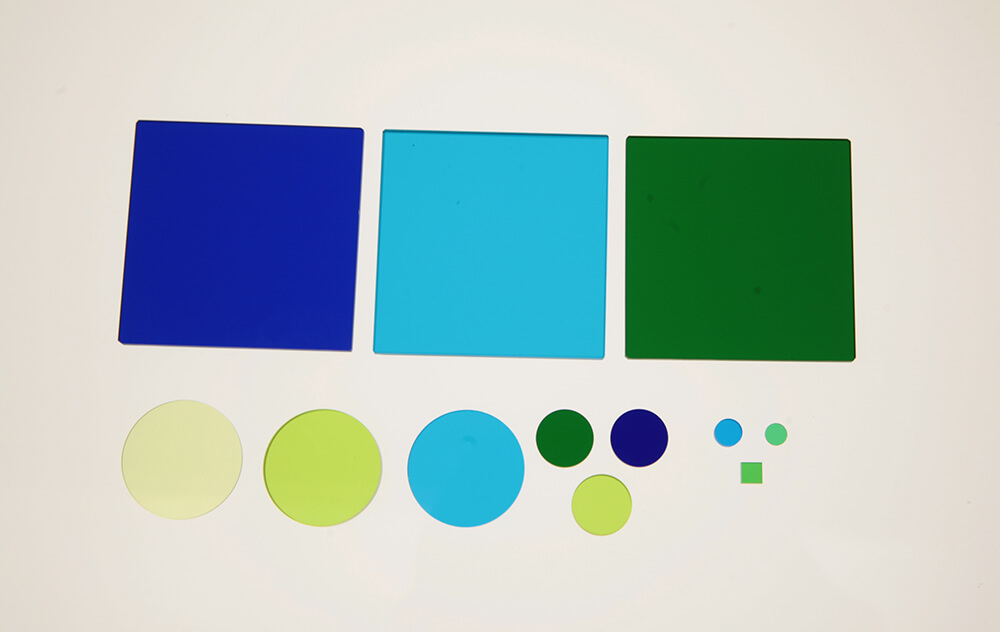Colour glass filters are essential in the field of optics for controlling light in a variety of industrial and scientific applications. These straightforward bits of coloured glass are the outcome of an intricate and exacting production process. We’ll take you behind the scenes today to see the complex process that takes basic resources to final output.
The Foundation: Raw Materials
Every colour glass filter starts with a carefully chosen glass substrate. Usually, manufacturers employ premium glass from well-known vendors like Schott or Hoya. The substrate selection is crucial since it provides the foundation for the filter’s characteristics.
The dye that gives the filter its colour and spectrum characteristics is the second essential component. These dyes are carefully blended substances intended to react differently with light. The intended wavelength range and the final filter’s optical density dictate the dye choice.
The Art of Dye Injection
Science and artistry meet in the process of adding dye to the glass substrate. Manufacturers inject the dye molecules into the glass matrix using a process known as ion exchange or diffusion. In order to do this, the glass must be heated almost to its melting point and placed in a precisely regulated atmosphere that contains the dye.
The trick is to get the dye evenly distributed throughout the glass. To guarantee consistent results, specialised equipment keeps an eye on and modifies temperature, pressure, and exposure duration. Extreme precision is needed at this stage since even little deviations can cause the filter to behave inconsistently.
Controlling Filter Properties
The precise characteristics of a coloured glass filter are dictated by two primary elements: the dye concentration and glass thickness. The light transmission and absorption properties of the filter can be precisely tuned by manufacturers by varying these factors.
Deeper colour and more noticeable filtering effects are typically the product of thicker glass or larger dye concentrations. Finding the ideal mix is essential, though. Excessive light loss can result from using too much dye, and inadequate dye may not give the required spectrum performance.
Precision Manufacturing Techniques
The coloured glass goes through a number of exacting production processes after it has cooled. With the aid of sophisticated cutting instruments and, frequently, water jet or laser cutting technologies, the glass is precisely cut to size. After that, the edges are polished and honed to provide the necessary dimensional precision and surface quality.
The filter surfaces’ parallelism and flatness are crucial for numerous applications. In order to attain surface precision expressed in fractions of a wavelength of light, optical polishing procedures are utilised. This degree of accuracy guarantees that undesirable optical effects are not introduced by the filter.
Customisation and Flexibility
While many colour glass filters are manufactured to conventional specs, advanced producers can construct unique filters. This necessitates a flexible production method that can be tailored to unique customer needs.
Customisation may entail designing unique substrate and dye combinations, manufacturing filters with gradient colour density, or producing filters with particular forms and sizes. Manufacturers must strike a compromise between the efficiency of standardised production and the flexibility required for custom orders.
Rigorous Testing and Quality Assurance
Quality control is critical in the manufacture of colour glass filters. Each filter is rigorously tested to ensure it fulfils the necessary criteria. Spectrophotometers are used to measure the filter’s transmission and absorption properties over the appropriate wavelength range.
Durability testing is particularly important because these filters frequently have to survive extreme environmental conditions. Temperature stability, humidity resistance, and even radiation hardness tests may be performed according on the desired application.
Innovations in Manufacturing
The field of colour glass filter production is not static. Ongoing research and development activities aim to improve production methods and enhance the capabilities of these filters. Recent advancements include the creation of new dye compositions with improved stability and spectrum range.
Advances in nanotechnology are also making an impact in the sector. Some firms are investigating the use of nanoparticles to make filters with more precise and adjustable optical characteristics. This could result in a new generation of filters with capabilities that exceed what is now available.
Environmental Considerations
In recent years, there has been a greater emphasis on the environmental impact of industrial processes. Progressive colour glass filter makers are taking steps to reduce waste and energy use. This involves recycling glass offcuts, increasing furnace efficiency, and investigating more ecologically friendly dye compositions.
From Factory to Application
The journey of a colour glass filter doesn’t end at the factory. Manufacturers work closely with clients to ensure that the filters are properly implemented in their intended applications. This may involve providing guidance on handling, mounting and maintenance to ensure optimal performance and longevity.
Behind every colour glass filter lies a story of innovation, precision and craftsmanship – a testament to the ongoing pursuit of excellence in the world of optics.
Do you need high-quality colour glass filters for your project or application? Whether you require basic filters or unique solutions, we are here to assist. Contact our team of professionals who are ready to help you select the ideal colour glass filters to fit your individual needs.




